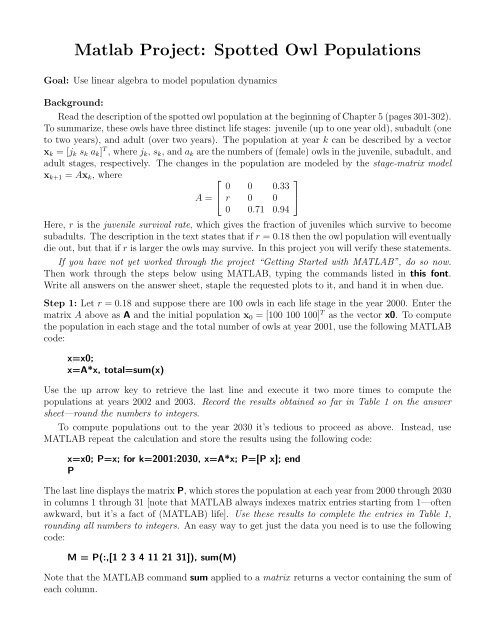Matlab Project: Spotted Owl Populations
Matlab Project: Spotted Owl Populations
Matlab Project: Spotted Owl Populations
You also want an ePaper? Increase the reach of your titles
YUMPU automatically turns print PDFs into web optimized ePapers that Google loves.
<strong>Matlab</strong> <strong>Project</strong>: <strong>Spotted</strong> <strong>Owl</strong> <strong>Populations</strong>Goal: Use linear algebra to model population dynamicsBackground:Read the description of the spotted owl population at the beginning of Chapter 5 (pages 301-302).To summarize, these owls have three distinct life stages: juvenile (up to one year old), subadult (oneto two years), and adult (over two years). The population at year k can be described by a vectorx k = [j k s k a k ] T , where j k , s k , and a k are the numbers of (female) owls in the juvenile, subadult, andadult stages, respectively. The changes in the population are modeled by the stage-matrix modelx k+1 = Ax k , where⎡⎤0 0 0.33A = ⎣ r 0 0 ⎦0 0.71 0.94Here, r is the juvenile survival rate, which gives the fraction of juveniles which survive to becomesubadults. The description in the text states that if r = 0.18 then the owl population will eventuallydie out, but that if r is larger the owls may survive. In this project you will verify these statements.If you have not yet worked through the project “Getting Started with MATLAB”, do so now.Then work through the steps below using MATLAB, typing the commands listed in this font.Write all answers on the answer sheet, staple the requested plots to it, and hand it in when due.Step 1: Let r = 0.18 and suppose there are 100 owls in each life stage in the year 2000. Enter thematrix A above as A and the initial population x 0 = [100 100 100] T as the vector x0. To computethe population in each stage and the total number of owls at year 2001, use the following MATLABcode:x=x0;x=A*x, total=sum(x)Use the up arrow key to retrieve the last line and execute it two more times to compute thepopulations at years 2002 and 2003. Record the results obtained so far in Table 1 on the answersheet—round the numbers to integers.To compute populations out to the year 2030 it’s tedious to proceed as above. Instead, useMATLAB repeat the calculation and store the results using the following code:x=x0; P=x; for k=2001:2030, x=A*x; P=[P x]; endPThe last line displays the matrix P, which stores the population at each year from 2000 through 2030in columns 1 through 31 [note that MATLAB always indexes matrix entries starting from 1—oftenawkward, but it’s a fact of (MATLAB) life]. Use these results to complete the entries in Table 1,rounding all numbers to integers. An easy way to get just the data you need is to use the followingcode:M = P(:,[1 2 3 4 11 21 31]), sum(M)Note that the MATLAB command sum applied to a matrix returns a vector containing the sum ofeach column.
Step 2: Type the following to plot the populations as functions of time:year=2000:2030; plot(year,P)Here year is a vector giving the year numbers; since the length of this vector matches the number ofcolumns of the matrix P, the plot command plots the three rows as three separate lines of differentcolors. Label your plot using the following code:title(’<strong>Spotted</strong> <strong>Owl</strong> <strong>Populations</strong>: r=0.18’)xlabel(’year’), ylabel(’population’)legend(’juvenile’,’subadult’,’adult’)Print the graph (to hand in with the answer sheet). Does it look like the owls will survive? Recordyour answer on the answer sheet.Step 3: To see what might happen if environmental conditions were changed so that more juvenilessurvive, change the value of the juvenile survival rate r to 0.30 and repeat steps 1 and 2. To dothis, type A(2,1)=0.30 (check the resulting matrix) and then repeat the calculations of step 1 andthe graph of step 2 (remember to change the value of r in the plot title). Does it look like the owlswill survive? Record your answers in Table 2 on the answer sheet (round numbers to integers) andprint the graph (to hand in).Step 4: Repeat the above calculations and graphs for the following values of the juvenile survivalrate r: 0.20, 0.22, 0.24, 0.26, and 0.28. You do not have to record all data or print graphs for these.Instead, record the total population at year 2030 for each value of r in Table 3 on the answer sheet.Hand in the following:1. The completed answer sheet. DO NOT hand in the instructions (I already have a copy).2. A printed copy of your graphs from steps 2 and 3.3. If you use an M-file (MATLAB script) to do these calculations, also attach a copy of it.Remarks:• The for command executes a loop. For further information about this or any other MATLABcommand, use the help command (e.g, help for) or see the Help menu within MATLAB.• To print a graph you can select Print from the File menu on the Figure window (or Exportthe graph to a file to include it in some other document).• This project is adapted from the Instructor’s MATLAB Manual by Jeremy Case and Jane Day.
















